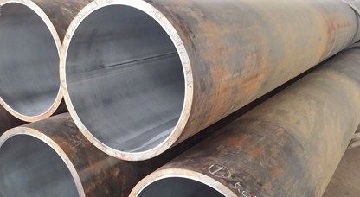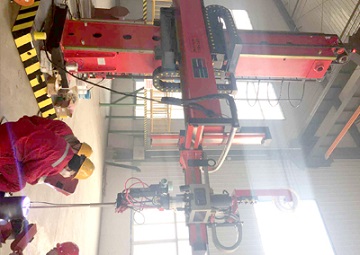CRA Clad or Lined Steel Pipes
1. What’s a CRA Clad or Lined Steel Pipe?

The CRA clad or lined pipe is composed of a conventional carbon steel or low alloy steel pipe and a corrosion-resistant alloy layer. CRA refers to corrosion-resistant alloy. The CRA layer is metallurgically bonded (clad) or mechanically bonded (lined) to the internal or external surface of the steel pipe. The carbon steel or low alloy steel pipe is called base metal, or backing steel; The CRA layer is usually called cladding material or lining. This is economically favorable for large-diameter heavy pipelines since the relatively much thinner CRA layer not only retains enhanced corrosion-resistant properties but also reduces the cost to the minimum. The CRA clad or lined steel pipes are widely used in pipeline transportation systems in the petroleum and natural gas industries. They are also extensively used for marine applications, chemical plant, and power plant, etc.
2. Material Selection and Standard Specification
Base materials of the CRA clad or lined steel pipes include seamless or welded line pipes of API 5L Grade B, X42, X46, X52, X56, X60, X65, X70 and X80. In other circumstances, the base metal can also be provided as ASTM A106 Gr.B, ASTM A333 Gr.6, ASTM A335 Cr-Mo alloy steels (P5, P11, P22, P9, P91), etc.
The CRA cladding or lining material covers an extensive range of stainless steels and nonferrous alloys: SS 304/304L, SS 316/316L, SS 317/317L, Duplex 2205 (S31803), 2506 (S31804), 2507 (S32750), S32740, Alloy 254 SMO (S31254), 904L (N08904); Incoloy alloy 825 (N08825), Inconel alloy 625 (N06625), Hastelloy C-276 (N10276), Inconel alloy 59 (N06059), Alloy 31 (N08031), AL6NX (N08367), Alloy 20 (N08020), Monel alloy 400 (N04400); Titanium Grade 2, 5, 7, 9, 12; zirconium R60702; and some copper alloys.
Generally, CRA clad or lined pipes shall be manufactured as per API 5LD. The base material (steel pipe) conforms to API 5L, ASTM A106, ASTM A333, ASTM A335, etc. The cladding material shall conform to ASTM A240, A263, A264, A265, B898, B424, B443, B619, B622, B675, B265, B551.
Manufacturing of CRA Clad or Lined Steel Pipes
The CRA clad steel pipe is a bimetallic pipe composed of an internal (and in some cases external) CRA layer that is metallurgically bonded to the backing steel. The cladding may be bonded by hot rolling, coextrusion, weld overlay, explosion bonding, powder metallurgy, or some other process that produces a metallurgical bond. The CRA lined steel pipe consists of a carbon steel or alloy steel pipe with an internal or external CRA liner. The CRA liner is affixed or tightly fitted to the base-metal pipe full length by expansion, compression cold forming, or some other means. The CRA liner may be a tube or pipe inserted into a steel pipe, a plate or sheet rolled into a cylinder by expanding the liner and/ or shrinking the base pipe, or by some other applicable processes. The clad process results in a quite firm metallurgical bonding at the interface of the backing steel and the CRA layer. The mechanical bonding formed by the lining process is relatively “loose” in a lined pipe. Although the clad pipe exhibits better mechanical performance, its cost is relatively higher.

The CRA clad or lined pipes supplied by our company can be sized from 1″ (DN 25) to 100″ (DN 2500) with a minimum CRA layer of 2.5 mm in thickness and a maximum length of 15 meters. Heat treatments for both the base-metal pipe and the CRA layer shall be rigorously conducted. Generally, the line pipe will be furnished in annealed condition while the CRA layer will be furnished in solution-annealed condition. The chemical composition of the backing steel and CRA layer shall be in conformance to its relative material standard specification respectively. Generally, the mechanical properties of the CRA clad or line pipe is determined by the properties of the base material alone. The mechanical propertis of the CRA layer may be specified by the purchaser.
3. Tests and Inspection
- Tensile tests: The CRA layer shall be removed from all specimens of finished products; Longitudinal tensile tests and transverse tensile tests; Weld tensile test (if there is any weld seam in the backing steel).
- Flattening tests.
- Guided-bend tests.
- Fracture toughness tests.
- Hardness tests (Vikers – ASTM E 384, Rockwell – ASTM E 18).
- Ferrite/austenite ratio for duplex stainless steel CRA layer.
- Corrosion tests as per ASTM A262 Practice B or Practice E, ASTM G28 Method A, ASTM G48 Method A.
- Tests for CRA cladding bond strength and CRA liner tightness.
- Residual magnetism (less than 15 Gauss).
- Hydrostatic inspection.
- Dimensional inspection and visual examination.
- Ultrasonic inspection for clad pipes.
- 100% X-Ray inspection for all welds.
